
Table of Contents
Overview of Agile Methodology
Agile methodologies are the approaches to the development of a product. The principles and values reported in the Agile Manifesto of software development regulated them. The primary aim of the agile development methodology is to deliver the best product through a cross-functional organizing team.
People always have a question in their mind and want to know what agile methodology is?
Agile is the capability to carry out and respond to any kind of modification. It is the process of approaching and flourishing in an insecure and jubilant situation. This is an interactive approach for software development and project management.
It helps a team to provide fast and unquestionable responses to the feedback they get on their application. It allows them to analyze the project’s direction during the development process. The developer’s team continually assesses the project in their regular meeting, known as “Sprints“.
It allows developers’ teams to deliver a rating to their customers quicker with no strain. Agile developer’s teams have a natural mechanism for responding to assess plans, results, and requirements. They deliver work in small but consumable increments.
This blog will see both processes and dig deeply into how agile development can help create web assets fast.
What is Agile Software Development?
Agile software development is a robust approach used to build web assets. These development processes allow developers for various channel development and a non-stop cycle of testing and improvement. The agile approach also has a distinction with waterfall development, which is an entirely linear process.

Agile software development has more value than a framework like FDD (feature-driven development), Scrum, and Extreme programming. We may use the term “umbrella” for software development agile. Software development agile is more than practices.
For example, you may take the name of pair programming, stands up, sprints, and test drove development. Why do we use the term “Umbrella“? Because agile software development is a set of agile frameworks and practices. Agile software differs from others because it highlights the people doing the work and how they work together.
The community of agile software development focuses on collaboration and the self-organizing team. It means that teams have the potential to point out how they’re approaching things on their own. Hoping you must have understood what agile development is.
Agile Project Development
Agile project management is a monotonous approach to software development projects. They ensure fast action towards feedback, allowing the project management team to accept the methodology of working quickly.

They have to also work within the time framework and budget of a project. This management team covers various agile software development methodologies. But, please note there is no single agile development methodology.
Are you eager to know what an agile methodology in software development is?
Well! The team of the agile project management team has rich experience in software development. They have proved that they have the heavyweight tradition of project management methodology. (Like a waterfall). They found the troubles of these heavyweight methods, for example, adaptability, lack of flexibility, and others.
In 2001, a group of software developers got together to discuss the core value of agile software development. They find out the primary reason behind it. They discovered the Manifesto for Agile Software Development. This Manifesto was the collection of values and principles and came to know how to become agile.
What is the Agile Manifesto?
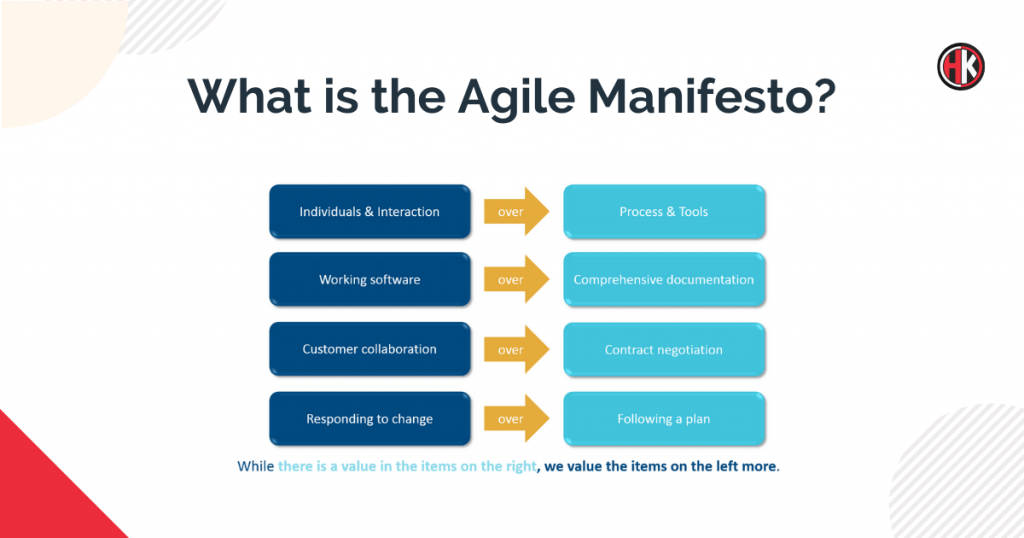
This is a statement of core values and principles regarding software development. They set it up in the year 2001 and a declaration of 4 fundamental rules and 12 regulations.
This agile Manifesto works as a guide for the developers in agile software development methods. Seventeen top professionals in software development created this Manifesto. All these people already practised agile methods, for example, FDD, SCRUM, XP and others.
The Core Value of Agile:
As mentioned earlier, they mainly highlighted agile project development methods in software. If you create software or something like that for any marketing campaign, you can apply so many things. It does not depend on which field you are working in.
They base all agile development processes on the Agile Manifesto, which suggest a set of values by a group of developers. They want to guide their ideas about how agile software should develop.
The real Agile Manifesto declares that agile has four core values:
Customer partnership over contract negotiations is this core value. The agile developers’ team must work and communicate with customers with great attention. They can listen to them and get feedback that will help the team understand what they want.
Acknowledge Changing Over Following a Plan
Updates are a continuous process in any kind of software development. These things show that software is software working correctly. Looking at these things, a project plan and budget must be flexible enough to change when it needs any change.
Individuals and Interactions Over Processes Along with Tools
This value focuses on communication and Teamwork, which is essential in software development. As we know, software development is human activity, and the quality of interaction is necessary. The tools play a fundamental role in software development. To satisfy customers, creating helpful software depends upon Teamwork.
Functional Software Over Comprehensive Documentation
Documentation has its importance in their segment. This is a valuable resource for users and coworkers. However, the major aim of any software development is to provide business benefits compared to extensive documentation.
These core values are at the centre of all agile project management approaches.
Also read: What Is Progressive Web App? How Does PWA Work? Complete Guide 2021
12 Principles of Agile
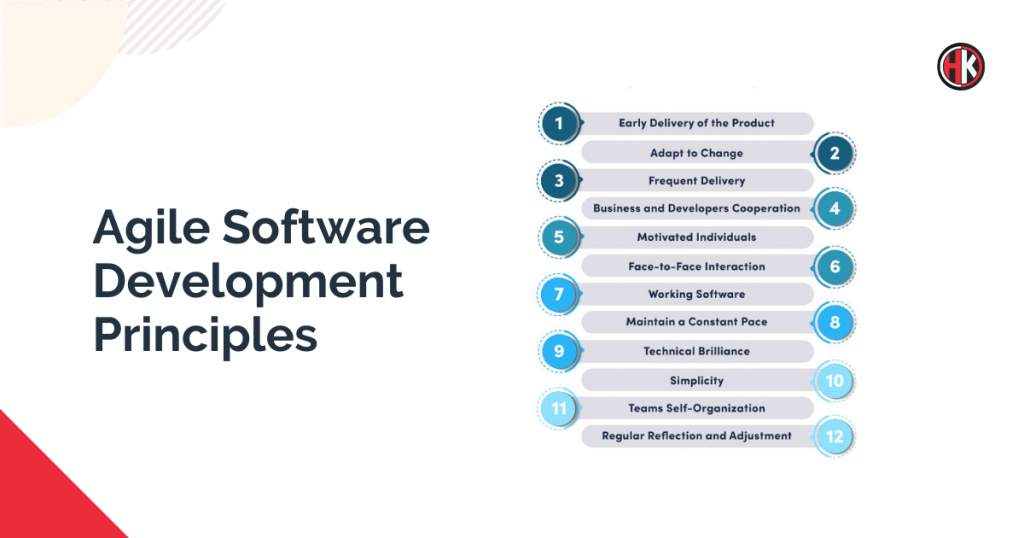
There are 12 principles of agile software development:
1. Customer satisfaction by offering valuable software regularly.
2. Welcome change of requirements, how early or late in the running project.
3. Deliver the software that works within a lesser time frame.
4. Both customers and developers must work together frequently throughout the project.
5. Transfer of information between parties in the one-to-one discussion.
6. It is important to motivate a customer to create a project by developing an environment of appreciation, trust, and empowerment.
7. Running software is a key to progress.
8. The agile development process allows sustainable development.
9. Always focus on excellence and quality in the technical development of software and design.
10. User-friendly software is a prime part of effective, agile management.
11. A well-managed team can produce the top architecture, needs, and design.
12. A good team should reflect by inspection and adaptation that would be more fruitful.
Various methods of agile development processes promote the values and principles of the Manifesto. Scrum and XP are two major examples.
What is the Agile Process?
The agile process breaches a bigger software project into several smaller parts to develop further. This iteration approach differentiates agile management from others. Various researches have proved that there is a negative interaction between project size and success.
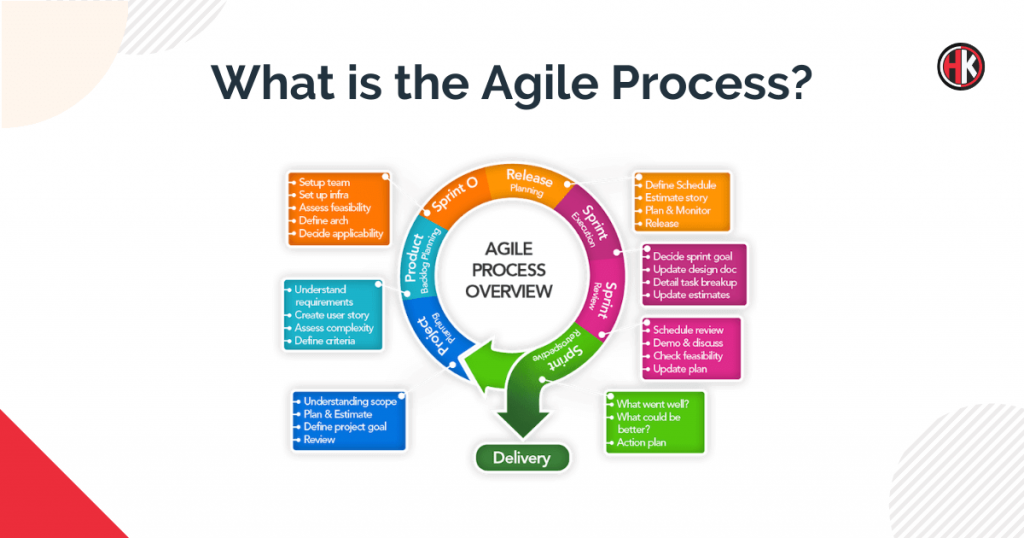
You can say like this, the smaller the project size, the greater the success rate.
Top 10 Benefits of Agile Software Development
- More flexibility and less risk.
- Good customer satisfaction.
- A cheerful team.
- Expected costs and agenda.
- Adjustable Preferences.
- Target on business value.
- Improves Quality.
- Focus on Users.
- Allows for Change.
- Transparency.
After describing every aspect of agile software development in this blog, it is essential to know the advantages of this tool. After organizing several meetings, developers find out various benefits of agile software development. They faced multiple challenges in real-life projects. Find the various reported benefits of this agile project management.
More Flexibility and Less Risk
The top benefit of the agile method is the ability to control changing priorities. You can get the data with an agile, iterative approach and focus on regular feedback during the entire development process. The developers ‘ team can boost project predictability with designated quick sprint cycles, regular reporting updates, and clear project visibility. It reduces the risk appetite of the business owner.
Good Customer Satisfaction
According to the agile methodology framework, good customer satisfaction is the criteria among the four core values of agile project management. You might remember this while going through the core value. The advantage of this is that excellent customer satisfaction comes only with greater collaboration.
The methodologies of agile project management encourage working closely with the customer. A great professional relationship with customers solves their issues along with a chance to get their future projects. Furthermore, through regular testing and review with all sprints of agile project incorporation, you may receive their actual real-time feedback.
A Cheerful Team
As we know, agile teams are more autonomous than others. Therefore, it grants liberty to guide some new thoughts and innovation, which lacks a traditional project methodology. We trust people to get the task done to see themselves as the top team members with such seriousness.
Expected Costs and Agenda
The average costs are limited and anticipated because Sprint is on a fixed schedule. They based all these things on the amount of work done. The customer will experience a better understanding of the approximate costs of every feature by adding the estimated expenditure before every Sprint. All these processes offer more decision-making space while arranging the features.
Adjustable Preferences
Agile Scrum methodology permits more preferences for customer-driven features. The agile team has more command in managing the transferable units of work with every sprint limit.
Target on Business Value
In the agile development process, the team better recognizes what is necessary for the customer’s business. It can distribute features that give the most significance to the company.
Improves Quality
In the agile software development process, it divided the projects into manageable units for better results. It helps them to concentrate on top quality development, collaboration and testing.
Focus on Users
In agile development, the user experience is used to say the product features associated with business acceptance parameters. Concentrating on business needs, every feature of the project provides real value. Furthermore, it offers an excellent chance to get essential feedback by beta testing the software after each agile Sprint.
Allows for Change
As per agile development methodology, the process regularly allows to prefer and refine the product backlogs. This helps the next iteration to introduce the new changes in a brief span.
Transparency
They based agile software development on the agile approach. It involves the customer throughout the entire project, including the review conference, iteration planning and recent feature creations in agile software development.
In short, agile principles can only be used for software development while creating any project for the customer.
Also read: Best Top 11 front-end frameworks of 2021 for web development
Steps of Agile Methodology
Agile project management believes in producing short development agile life cycles, including the regular release of products. It permits the team to control customer’s requirements effectively.
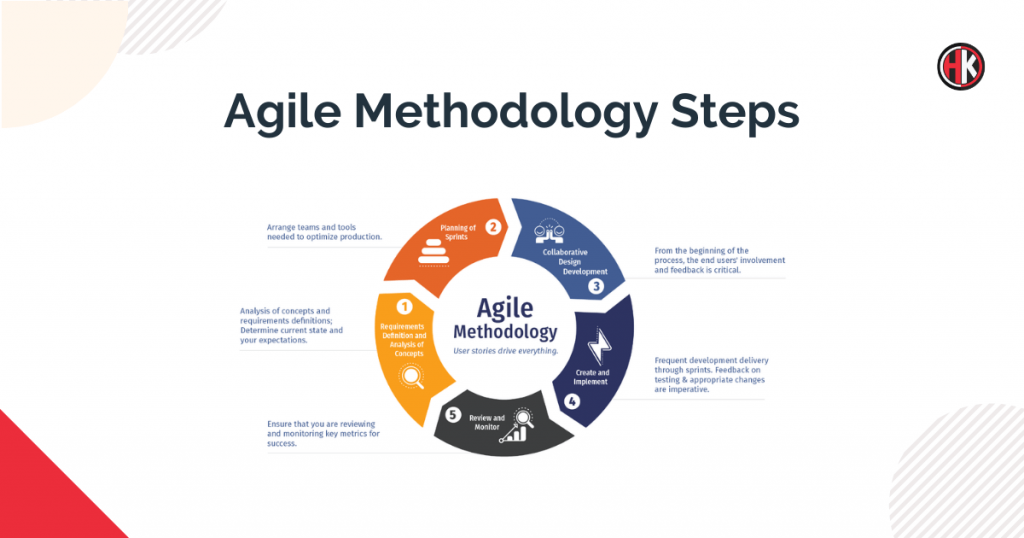
The popular agile frameworks are Kanban, Scrum, Dynamic software development method, Crystal methodologies, Extreme programming and Feature-Driven development method. All these agile frameworks have the same process in six basic steps.
Six Agile Methodology Steps:
- Planning of the project.
- Making the product guidelines.
- Planning for the Release.
- Planning the Sprint.
- Regular Stand-up Meetings.
- Sprint review and retrospective meetings.
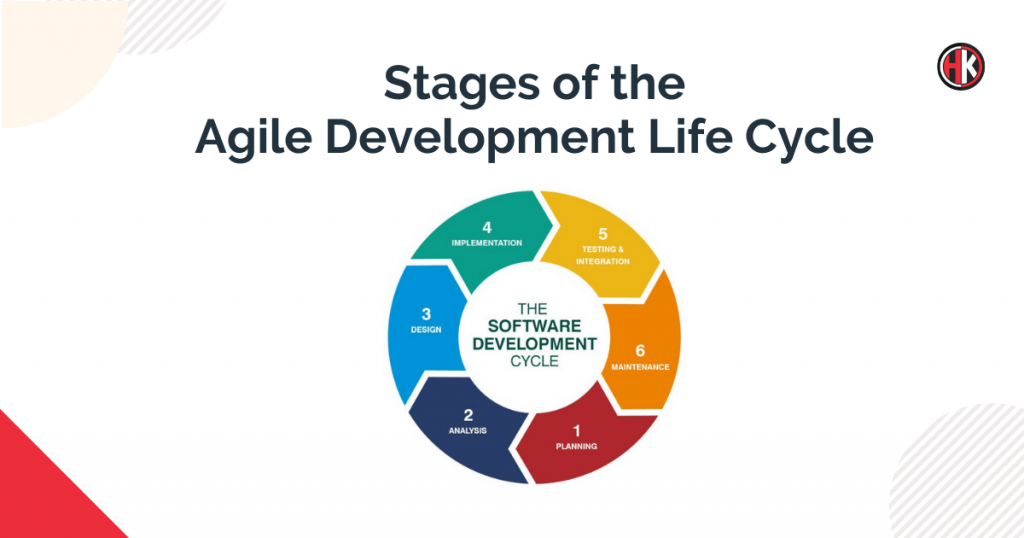
1. Planning of the Project:
Before developing any project for the customer, a team finds out the ultimate targets of the project. They also need to know the project value of their organization. After the awareness of these two factors, they need to know the steps to achieve the end goal for their clients.
2. Making the Product Guidelines:
A guideline about the product is all about the features of disintegration of the final product. In this stage, the agile team plans to develop the product during Sprints. Here, they also create a product backlog that contains all the tasks. Among all these agile methodology steps, this is the most important step.
3. Planning for the Release:
The third important step is planning for the Release of a product. It involves all the development processes before a release. During this step, the team delivers product features at the end of every minor development in the life cycle.
4. Planning the Sprint:
In this agile methodology step, a “Sprint planning meeting” is required to be held among the stakeholders before starting the actual “Sprint”. The principal purpose of this meeting is to assign particular specific work to each member. The head of the team briefs about those tasks for better results. A graphical workflow chart may be created to have a shared understanding and clear transparency among the team members.
5. Regular Stand-up Meetings:
This meeting helps the team members to discuss something special about the product development process. During this stand-up meeting, a participant can tell what he/she accomplished the day before. He also briefs what he/she is going to do on the same day.
6. Sprint Review and Reflective Meetings:
In the last step, we expect two more meetings at the end of each Sprint. A sprint review meeting and a sprint reflective discussion. They arranged this meeting with this purpose with the customer to show the end product. This review meeting also opens the door for any kind of important feedback.
6 Stages of the Agile Development Life Cycle
- Excavate and set up projects.
- Graphic requirements for the initial Sprint.
- Iteration.
- Release the iteration into production.
- Production and ongoing reinforcement for the software release.
- Retirement.
1. Excavate and Set up Projects:
In the first stage of the agile life cycle model, the team excavates and set-up projects. All members take individual responsibilities. Some members may handle one or more tasks at the same time. But it depends on the need for the projects. For every project concept, first, define the business opportunity and decide the time and work. You can assess technical and financial usefulness based on the above information.
2. Flowchart Requirements For the Initial Sprint:
After identifying the project in the agile model, plan your work with stakeholders to determine the actual needs. You might need to use a flowchart or high-grade UML diagrams to present. How should the new component function? Setting up these things, you may allocate work and resources to all the team members. It is also essential to create a deadline and clearly show when specific work is to be completed.
3. Iteration:
During the agile model in software engineering, once a team has fixed requirements for the first Sprint based on stakeholder feedback, the job begins. Developers and designers start work on their first iteration of the project. They aim while working on a project to launch at the end of a sprint. Please note one thing; the product will undergo various steps of revisions. Therefore, the iteration might include only minimal functionality.
4. Release the Iteration into Production:
You’re now preparing to release your product in the market. Hence, complete the software iteration with the following steps:
● Check the system- The quality assurance (QA) team will check functionality, record wins and losses and detect bugs.
● Check any defects
● Finalize design and user documentation- A “flowchart” can help you apprehend your code through UML diagrams. You may present user flows. Thus, everyone understands how the system functions?
● Release the iteration for production.
5. Production and Ongoing Reinforcement For the Software Release:
This agile methodology process phase involves constant reinforcement for the software release. Now your team member will keep the system running and present to users how to operate it.
6. Retirement:
In the retirement phase of the agile cycle, remove the system release from production.
Plan your any projects now and keep them on the right path with “Hackerkernel“.
Also read: How to Create A Social Media App: Complete Guide
Types of Agile Methodologies
- Scrum.
- Kanban.
- Extreme Programming (XP).
- Dynamic Software Development Method (DSDM).
- Feature Driven Development (FDD).
- Lean Software Development (LDD).
- Crystal.
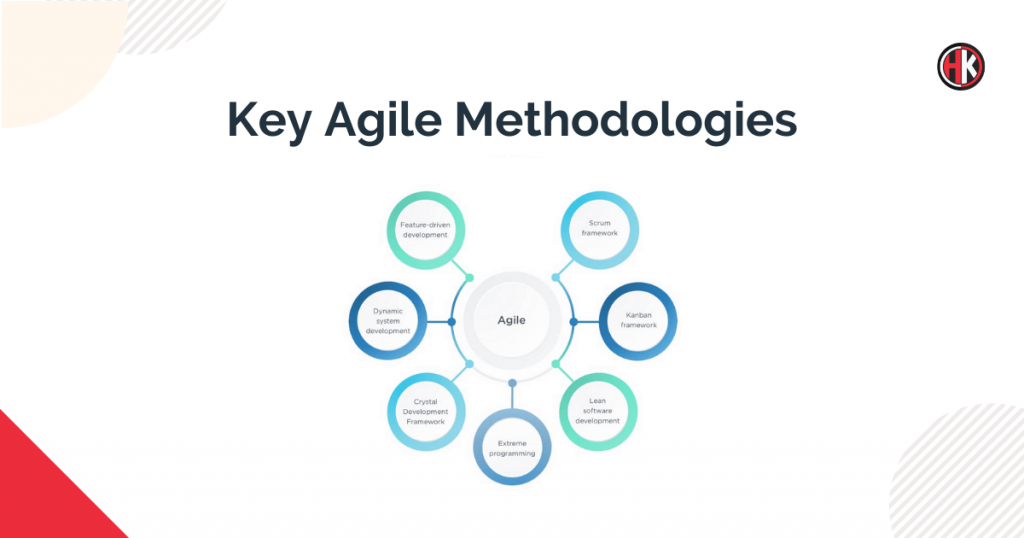
Agile methodology is a unique “umbrella” term for various methods and practices. Let’s see at some of the popular methodologies:
1. Scrum
This methodology is an easy, agile framework for working with complex projects. Ken Schwaber and Jeff Sutherland developed this methodology. Scrum and agile methodologies are iterative. They have break-down the work in iterations, and we call it Sprint in the language of Scrum.
A team of a minimum of ten people executes Scrum, including product owner and Scrum master. Sprints is a time frame in which they must develop a set of features.

They used it for managing software projects or application development. It comprises a collection of ceremonies, rules, values, artefacts, roles and best practices.
The scrum methodology divides the long waterfall process delivery into smaller cycles. This cycle helps product teams and customers to revise working software. They also ensure to meet the actual business needs. Regular stand-up meetings provide review and collaboration opportunities to the team to ensure that development is going in the right direction.
Advantages Of Scrum
- A low-cost option for the product owner.
- Experienced employee.
- The capability of completing complex tasks.
- Rapid distribution capacities of the product.
- High-grade software work products.
- The better outcome, as per the Agile Manifesto.
Disadvantages of Scrum
- It needs experienced team members than others.
- adopting the scrum methodology of large teams in a challenging environment.
- The regular sessions of the daily scrum process and product owner often frustrate team leaders and the entire picture.
2. Kanban
Kanban is another agile methodology that refers to workflow management methods. It helps envision the amount of work together and optimizes productivity. David Anderson introduced this method in the year 2000. They developed this method in response to some of the challenges of various agile methodologies.
Kanban solves traditional/ waterfall methods. This is a specific kind of visual system for managing work because it moves ahead through a process. In this optical system, workflow and actual work passing through this system save time.
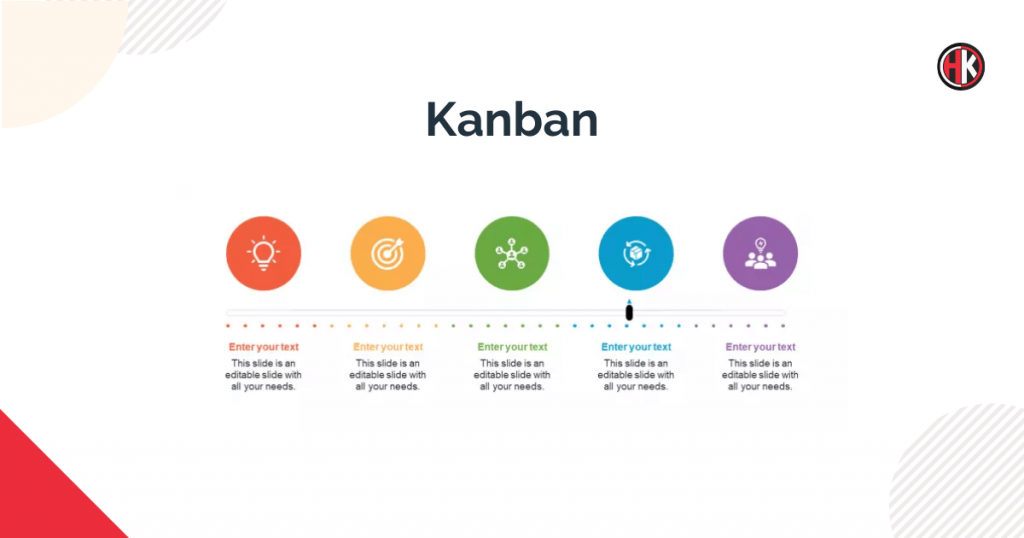
The primary purpose of this agile development model is to identify potential issues in your process and fix them. Therefore, a workflow is through it economically at a constant speed.
Benefits of Kanabn
- A good sense and flexibility in work.
- saves valuable time.
- Understanding and productivity improve.
- Continuous focus on software delivery and best practices.
- Solution evolves as per the Agile Manifesto.
Disadvantages of Kanban
- Not perfect for cases of shared resources.
- An issue with production flow.
3. Extreme Programming (XP)
This agile methodology is mostly simple named Extreme Programming(XP), and its credit goes to Kent Beck. It needs involvement in software development work between two parties. They are clients and software developers.
It enhances the consistency of the application in the context of increasing clients. The powerful programming technique is powerful, and it helps when there is changing demand. It is also suitable when the customer is not sure about the functioning of the system. The XP creates software keeping clients in the target.
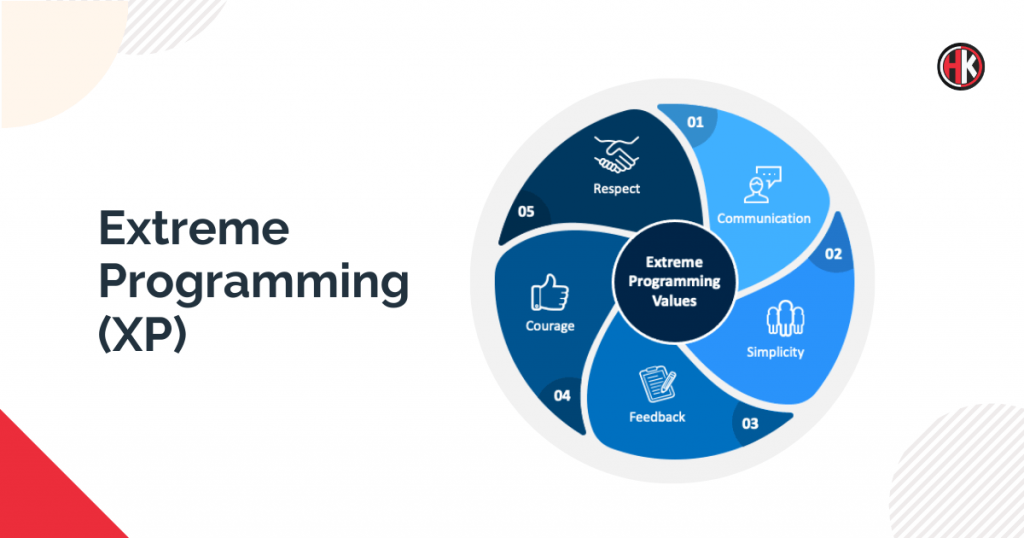
Advantages of Extreme Programming
- They have a good relationship with the customer.
- The team members deliver fast the project.
- The product is more agile because of frequent testing.
- Any kind of modification they made quickly.
- Code review of XP is easy.
Disadvantages of Extreme Programming
- More time-consuming in the group.
- A high price is a challenge form.
- It requires self-discipline teams, and all must speed upon each other.
- Customer participation is mandatory for better results.
4. Dynamic Software Development Method (DSDM)
The next agile methodology steps are the Dynamic software development process. This method is suitable to create an architecture for Rapid Application Development (RAD). This system is incremental and iterative that acknowledges the regular participation of customers. This methodology approach has progressed to offer a conceptual method of tailoring.
However, this is a concept that involves three phases.
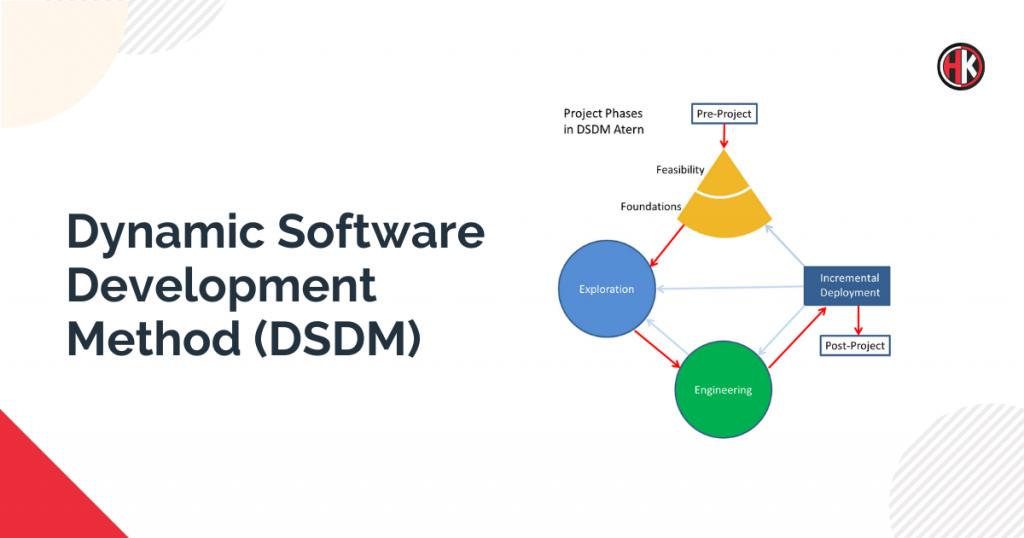
These phases are the pre-project phase, life-cycle phase and post project’s phase. Every step has its importance, values, and principles to follow. The Dynamic software development process approach has improved to provide a conceptual method for agile. The software helps to design, implement, and to optimize and iterative product development. Moreover, this agile process model uses different aspects. For example, prototyping and testing, times boxing, Moscow rules.
Advantages of DSDM
- Customer engagement is high.
- It delivered all functionalities quickly.
- On-time project delivery according to the agile Manifesto.
- Managing cross-functional teams.
Disadvantages of DSDM
- Not perfect for small project management.
- A complex methodology to understand.
5. Feature Driven Development (FDD)
Feature-driven development helps the developer team to be more responsive to customer requirements. Jeff De Luca initiated it in 1997. In this agile methodology, he has developed a model that uses five steps in a short iteration to focus on developing features.
These phases include developing software models, creating feature lists, planning by feature and design by quality, and building by quality. This is the most essential agile methodology, and you must consider making your project.
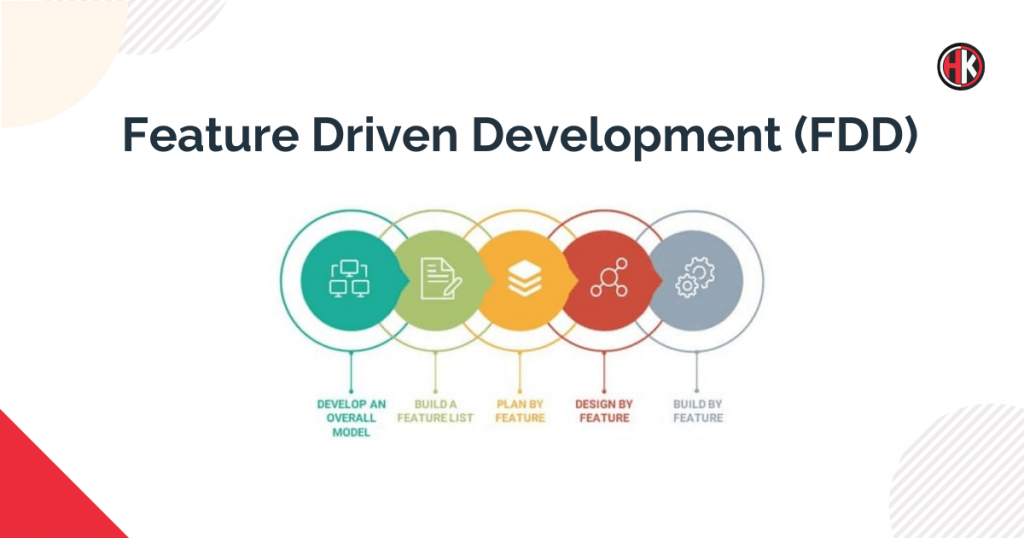
Advantages of FDD
- The team organizes fewer meetings.
- They try the user-centric method.
- Suitable for large-scale scale project management.
- One can quickly fix all the errors and track them.
- Through collaboration, they generate various solutions.
- They deliver all kinds of software products.
- Offers feedback loop and reports on time.
Disadvantages of FDD
- Not perfect for small team sizes project management.
- There is no focus on shared team ownership.
- They do not provide documentation to the clients.
- Does not work well with the old system.
6. Lean Software Development (LDD)
Lean software development is one of the best iterative agile techniques. It focuses on team members on offering value for customer stories by efficient business value source mapping. They provide a conceptual structure that applies the belief that e-commerce business best practices.
You may even extend to an agile approach to development.
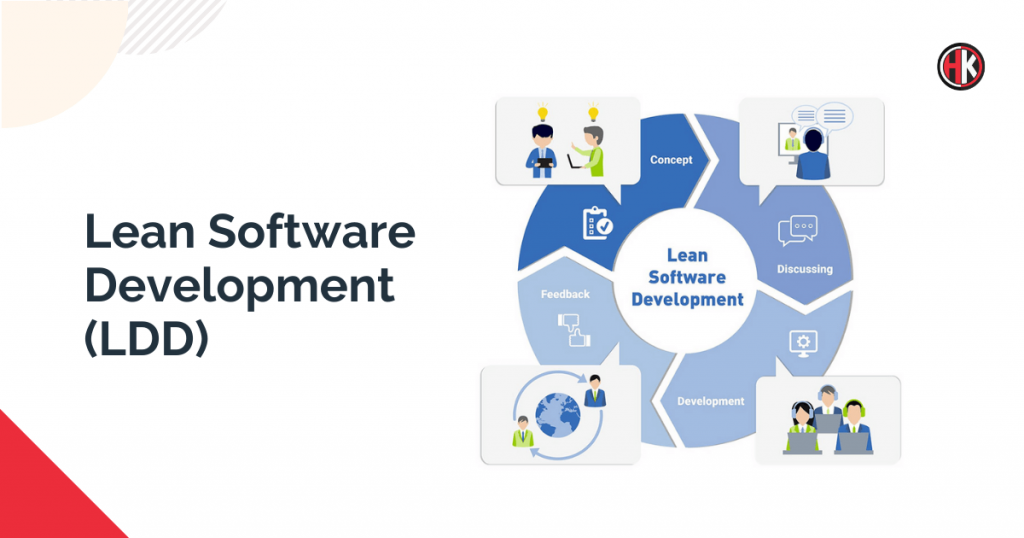
Advantages of Lean Software Development
- It takes lesser time to deliver working functionality.
- Easily scalable and better predictable.
- Ignores the superfluous activity.
- Solutions evolve through collaboration.
- High adaptability by development teams.
Disadvantages of Lean Software Development
- Reliant on the team’s ability.
- Most of the tasks are divided into various components, so the developer’s team faces issues.
- Need proper documentation.
7. Crystal
Crystal agile programming methodology is the most lightweight and adaptable approach in software development. This methodology depends on communication, people, interaction, transparency, skill and talent while operating on an agile project.
It is made up of various agile processes. This process includes crystal yellow, crystal orange, transparent and other methods. However, they also depend on multiple factors like the size of the team, preference of the project and criticality of the system.

Advantages of Crystal Methodology
- Ensures constant deliveries.
- Adapting various technologies to fulfil demands.
- High return on investment.
- Keep away from errors and problems.
Disadvantages of Crystal Methodology
- Different principles and unique values for other projects make crystal methodology unique.
- Teams and organizations require communicating more frequently to maintain a constant measure.
Also Read: What Is Progressive Web App? How Does PWA Work? Complete Guide 2021
Advantages and Disadvantages of Agile Methodology
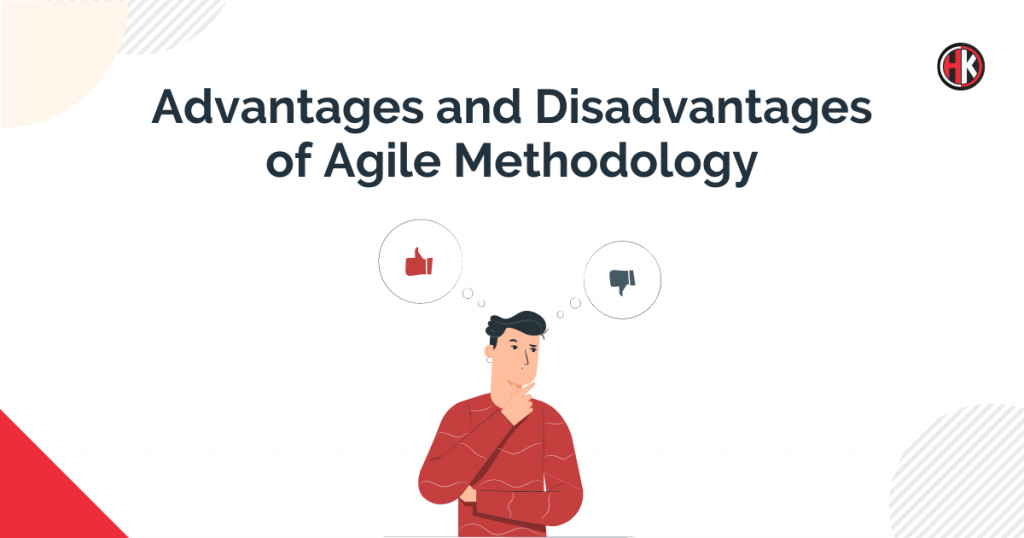
Advantages:
- Greater customer satisfaction because the delivery of software is fast.
- One to one communication from the project managers.
- Focus on technical features and good graphics.
- Frequent adoption of changing demand.
- Regular adoption of changing order.
- Good maintenance of all organizational synergy.
- Chances of innovation on items.
Disadvantages:
- Not suitable for small development projects.
- The developer’s team does not follow all the processes.
- Lack of documentation is a two-edged sword in the development process.
- Require training and decision-making skills.
- It requires experienced software engineering practices and teams.
- The agile methodology involves higher costs than others.
- It requires more planning in the development process. Otherwise, the product plan can fail
- They require continuous involvement, which is challenging for clients and developers.
Final words:
Agile development is an exciting approach to software development. When agile programming is done correctly, any company can find various ways to enhance the value of their end customer. Integrating the project developers and clients in the planning and implementing processes, the result is a more rewarding experience for everyone involved.
It gives a sense of satisfaction to those developers who are handling the project. It also evolves a positive experience in customers’ minds and produces a more fruitful outcome. Agile methodology is an umbrella term with many tools and practices based on values and excellent principles.
Therefore, if you plan to create agile software, make sure agile principles are implemented in the app development process. If you are facing any challenges, contact us. “Hackerkernel“ s expert team will guide you in every step of the development process.
Frequently Asked question:
What is an agile methodology for software development?
The agile method is an advanced technique that helps in software development and during the agile project’s software development life cycle.
What is the purpose of agile software development?
This is a process that transforms an idea into website solutions for a business. It is suitable to meet all kinds of business needs.
What is agile?
Agile is a term that includes a set of frameworks, practices, and principles. They enhance collaboration, speed and quality and approach to project management.
Why do customers like the agile model?
The agile model offers various advantages to the business owner to boost revenue and for project management. They help developers to manage the work more efficiently and deliver the project within their budget.
Mention the name of companies using agile
The MNC companies using agile are IBM, Microsoft, P&G and apple.

Husain Saify
Founder & CEO
Hey, I am Husain Saify, the Founder and CEO of Hackerkernel. I like to share some valuable information about Industry. You can also Reach Out to me On Linkedin.hello@hackerkernel.com





